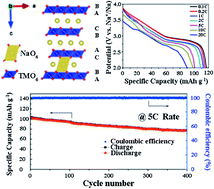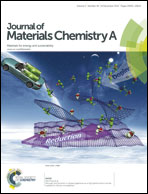O3-type layered transition metal oxide Na(NiCoFeTi)1/4O2 as a high rate and long cycle life cathode material for sodium ion batteries†
Abstract
High rate capability and long cycle life are challenging goals for the development of room temperature sodium-ion batteries. Here we report a new single phase quaternary O3-type layer-structured transition metal oxide Na(NiCoFeTi)1/4O2 synthesized by a simple solid-state reaction as a new cathode material for sodium-ion batteries. It can deliver a reversible capacity of 90.6 mA h g−1 at a rate as high as 20C. At 5C, 75.0% of the initial specific capacity can be retained after 400 cycles with a capacity-decay rate of 0.07% per cycle, demonstrating a superior long-term cyclability at high current density. X-ray diffraction and absorption characterization revealed reversible phase transformations and electronic structural changes during the Na+ deintercalation/intercalation process. Ni, Co and Fe ions contribute to charge compensation during charge and discharge. Although Ti ions do not contribute to the charge transfer, they play a very important role in stabilizing the structure during charge and discharge by suppressing the Fe migration. In addition, Ti substitution can also smooth the charge–discharge plateaus effectively, which provides a potential advantage for the commercialization of this material for room temperature sodium-ion batteries.


 Please wait while we load your content...
Please wait while we load your content...